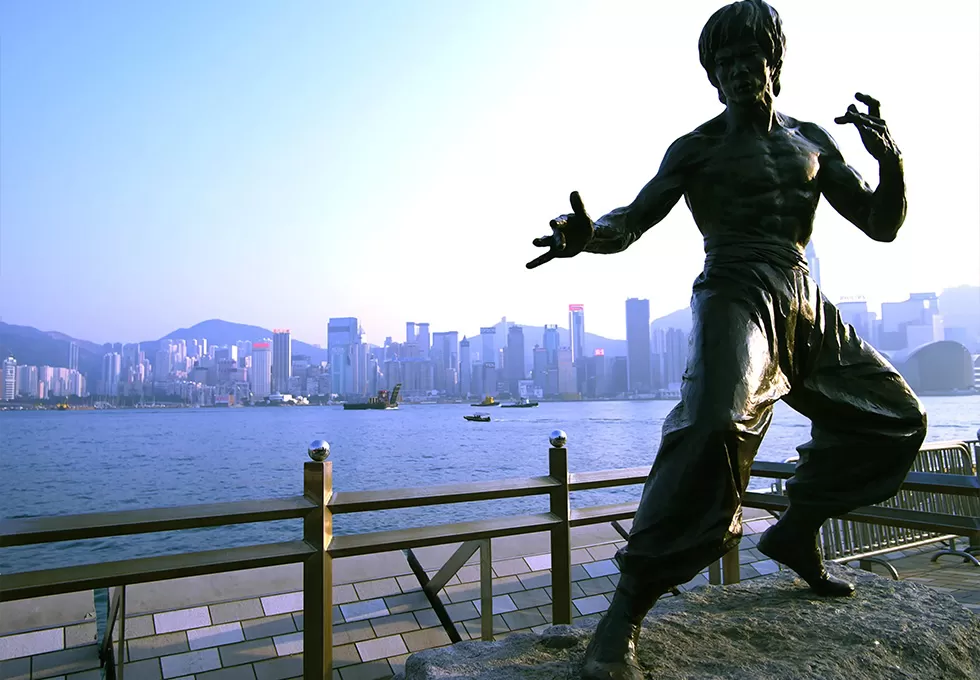Chinese Kungfu, Chinese Martial Arts
What is the function of Chinese martial arts?
Chinese martial arts, colloquially referred to as kung fu or gung fu and wushu, are a number of fighting styles that have developed over the centuries in China. People practice martial arts mainly for bodybuilding or defensive purposes. Today, martial arts are hailed as one of the four Chinese national treasures, the others being traditional Chinese medicine, Peking Opera, and calligraphy. And today, they still enjoy great popularity among Chinese people of different ethnic groups.
The Origin and History of Chinese Martial arts
Martial arts enjoy a time-honored history, with their roots in an early primitive society where man used sticks and stonewares to fight against the beasts. During this process, they came to have a mastery of some of the basic fighting tactics and techniques. With the emergence of war came improved individual fighting techniques. In the Pre-Qin Period, the vassals all attached much importance to the cultivation and training of soldiers, and as a result, the art of swordplay was further developed. In the Han Dynasty, Jue Di, a type of competitive game somewhat resembling boxing, was prevalent in society. Meanwhile, iron weapons were invented and used with certain fixed rules to be followed. In the Jin Dynasty, rules which were meant to be recited and followed by the practitioners served to guide the practice of martial arts. And this is regarded as the archetype of Chinese martial arts. Later the Tang Dynasty witnessed the prime time of martial arts. At that time, Empress Wu Zetian adopted the imperial martial arts examination system, which gave rise to the mushrooming of a number of martial arts talents. According to historical records, the history of the renowned Shaolin martial arts can be traced back to the early Tang Dynasty. In the Song Dynasty, Chinese martial arts entered a mature stage of development. Practicing martial arts for the purpose of bodybuilding became an important thing to do for people with lofty ideals. She, a type of martial arts club, also found its way into the life of ordinary people. It was in these clubs that people came together to study martial arts. At the same time, martial arts started to branch out to other sects and schools. In the Yuan Dynasty, martial arts training centers were established. In the Ming and Qing Dynasties, martial arts became increasingly popular among the ordinary folk, leading to a number of sects and schools. This was when martial arts started to take shape.
Shaolin, Wudang, and Emei, the three most renowned schools of martial arts
- 1. Shaolin martial arts, originating in Shaolin Temple, Henan Province, is thought to be rich in content, among which dragon boxing, tiger boxing, leopard boxing, snake boxing, and crane boxing are known as the five most famous types of boxing. For a thousand and more years, Shaolin boxing has evolved into two sects, namely northern sect Shaolin boxing and southern sect Shaolin boxing.
- 2. Wudang martial arts is famous for its origin in Wudang Mountain, Junxian County, Hubei Province. Originating in the late Yuan Dynasty and the early Ming Dynasty, Wudang martial arts witnessed their prime time in the late Ming Dynasty and the early Qing Dynasty. They revolve around the concept of t’ai chi, as evident from the skills named after the concept, such as “t’ai chi ch’uan” and “Taijijian”. They also focus on the use of “soft and gentle” techniques to overcome opponents who rely on brute strength and force.
- 3. Emei martial arts, native to Emei Mountain, started to take shape in the Ming Dynasty. They draw upon the merits of other schools of martial arts and develop their own unique techniques and styles. They stress the use of “soft and gentle” to gain an upper hand over opponents who rely on brute strength and force.
What is worth mentioning is that “qigong’, a kind of breathing exercise, enjoys a position of influence in Chinese martial arts. It is a method focusing on maintaining healthy status and bodybuilding, thought to be conducive to a longer life span.
Wrestling is a sport involving the participation of two competitors or sparring partners, who attempt to gain and maintain a superior position. In wrestling competitions, the wrestlers are divided into different groups according to their weight. The prime victory condition involves the wrestler winning by throwing and pinning his opponent on the mat. Wrestling is also a popular sport shared among many ethnic groups in China, such as the Mongolian, the Korean, the Kazak, and the Baoan people.
Taiji boxing, the most popular martial art in China
Taiji boxing features a combination of martial arts, traditional Chinese medicines, and such philosophies as Confucianism and Taoism. It is an internal Chinese martial art practiced for both its defense training and its health benefits. Having incorporated oriental wisdom, it is consistent with modern people’s quest for both mental and physical health. It is typically practiced for a variety of other reasons: its hard and soft martial art technique, demonstration competitions, and longevity. It also helps promote harmony in interpersonal relationships. As an intangible cultural heritage, it fully demonstrates man’s perception of nature.
China's most famous martial artist and action film actor
The 1970s witnessed a rising action film star, Bruce Lee. Born in San Francisco, Bruce Lee, whose father was a Peking opera performer, started to practice martial arts at the age of 10. He made his debut in The Green Hornet, starring a mask-wearing character, and in 1971, he did an excellent job in The Big Boss. In the films, Lee showed great national identity, and when doing fighting acts, he demonstrated his perfect martial arts techniques that held a great fascination with his fans. Since then, Chinese films have started to make their own way into the world market. The ambition and bravery he showed in the films were direct and Westernized, casting a sharp contrast to the preconceived ideas that Chinese characters were shy and implicit in nature. Lee was a devout follower of Taoism. Many of his words had ideas that indeed transcended the limitations of his historical background. He believed that the ultimate martial arts were an honest expression of a self. He also drew an analogy, saying, “We need to empty our minds so that they can flow as freely as water. If we pour water into a cup, then it will take on the shape of a cup; if we pour water into a bottle, then it will take on the shape of a bottle; if we pour water into a teapot, then it will take on the shape of a teapot. The water that bears the boat is the same that swallows it up. All of us need to be like water.”
Why are Chinese martial arts not as widely practiced as before?
Why ancient people liked practicing martial arts:
- (1) The recreational activities back then were quite limited, so practicing martial arts was a good choice to kill time;
- (2) Martial arts could be practiced for the purpose of self-defense, protecting families, and helping others. (3) Practicing martial arts could help achieve an individual's dreams. In the old days, one’s social standing was pretty much dependent upon their level of martial arts. The higher level they could reach, the more respect they would receive from others. Besides, one could also serve in the army and achieve self-actualization on the battlefield. For this reason, practicing martial arts was more of a trend in society.
Today, practicing martial arts has lost its ground for the following reasons:
- (1) In the battlefield, modern hi-tech equipments and weapons have rendered martial arts unnecessary.
- (2) People nowadays have a variety of recreational activities to choose from. If they want to do some exercise for bodybuilding purpose, then they can play basketball or football. And the society tends to be stable and safe when compared to that of the ancient times, so people are not motivated to practice martial arts.
- (3) It entails a large amount of time and energy to practice martial arts. And the practice will be very likely to get one nowhere in his career, not to mention buying a house or a car. After all, one has to build his own family one day, which will definitely ask for a good career and stable financial status. In this context, someone practicing martial arts is not thought to have a bright future.
- (4) With the popularization of the nine-year compulsory education, parents all want their children to be admitted to good universities, which will help them land a better job in the future. Today, some students are overburdened by study, and having a good sleep sometimes becomes a luxury that they cannot afford. In such a context, it is simply impossible for them to spare some time to practice martial arts. Even if they want to learn martial arts, their parents would still stand in the way.
If I intend to learn some Chinese martial arts, which itinerary should I choose?
There are a bunch of people practicing martial arts in Beijing's Heavenly Temple. If interested, you can simply join them and give it a shot. Or you can watch some martial arts performances during the nighttime. You can even have several hours' practice by yourself. The same is also true in many other places. You can learn how to play taiji boxing on the ancient city walls in Xi'an; you can practice sword playing to the music by the bank of the Li River. If these should fail to satisfy you, we can arrange a trip to Shaolin Temple for you. You can definitely have a glimpse of the most authentic Chinese martial arts there. To get there, you can take an airplane from Beijing or a high-speed train from Xi'an. It only takes two hours to get to Luoyang, which is home to Shaolin Temple.
GREAT FAMILY CHINA TOUR
JULY 2024 We wanted to thank Grace at China Culture tour for organizing a great tour of China. We enjoyed our Beijing - Xian-Chengdu -Guilin -Yangshuo - Shanghai trip. Our local guides Bruce in Beijing, Susan in Xian, Jane in Chengdu, Mike in Guilin and Mary in Shanghai took care of us…read more details »
Teng Han L from SINGAPORE
Ready to Create a Unique Dream Travel?

